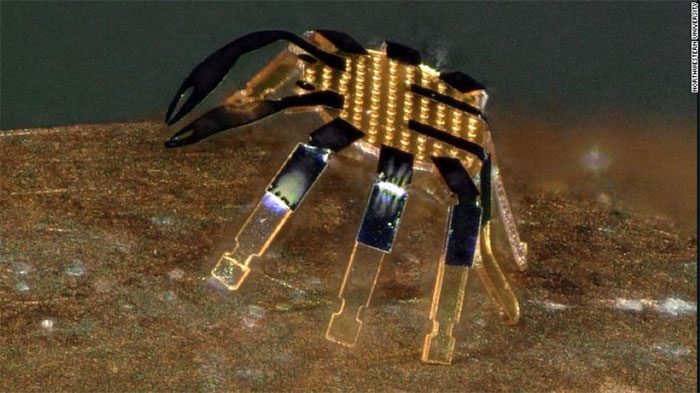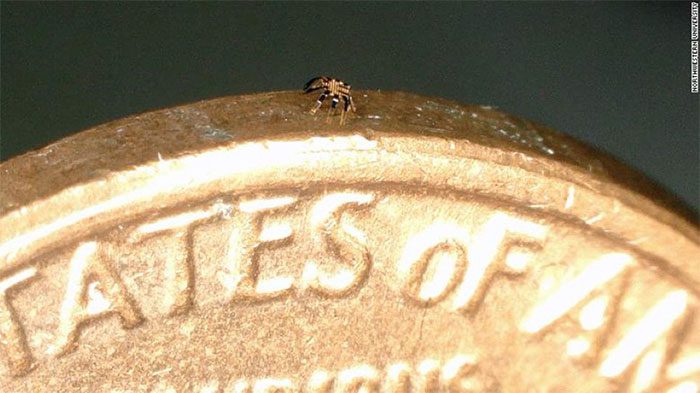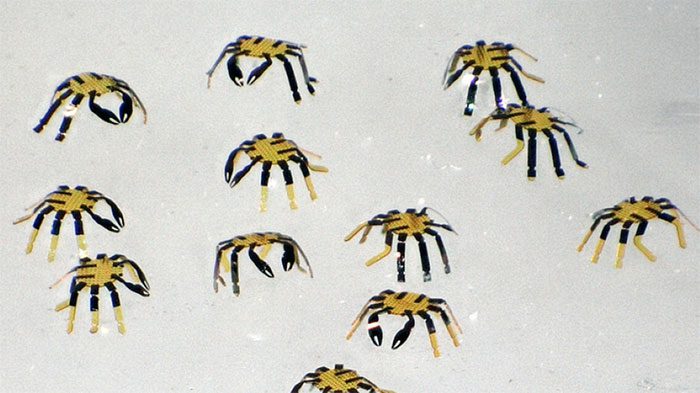In a year and a half, engineers at Northwestern University in Evanston, Illinois, have invented the world’s smallest walking robot.
The crab-shaped robot, smaller than a flea, is extremely agile; it can bend, twist, crawl, walk, turn, and even jump. The research was published in the journal Science Robotics and opens up opportunities for many useful applications in the future.

The tiny robot moves with the help of laser beams.
Inspired by Children’s Pop-Up Books
The head of the research project is scientist John A. Rogers. He stated that robotics is an exciting field of research, and the development of microrobots is a captivating topic to explore.
According to Yonggang Huang, who is responsible for the theoretical aspects of the project, they have harnessed technology to control various movement methods of the microrobot. However, this robot moves much slower than a flea, covering a distance equal to half its body length every second.
Yonggang Huang believes that achieving such capabilities in a tiny walking robot is a significant challenge. But now they can fabricate walking robots in any size or 3D shape.
To create a creature as small as half a millimeter wide, Rogers and Huang turned to a technique they introduced eight years ago. This method is inspired by pop-up children’s books.
First, the research team constructed an initial version of the crab walking structure in a flat geometric form. They then adhered this structure to a slightly stretched rubber base. When the stretched layer is relaxed, a controlled displacement process occurs, causing the crab to “pop up” into precisely defined 3D shapes.
No Motors Used

The crab robot is thinner than a coin.
The tiny crab-shaped robot, which is thinner than a coin, does not operate using complex hardware, hydraulics, or electricity. Instead, its power lies in the elasticity of its body.
The scientists used a material called “shape memory alloy”, which can remember its original shape and transform into a “memorized” shape when subjected to heat.
In this case, the researchers used a laser beam to quickly heat the robot at different targeted locations on its body.
A thin elastic glass coating helps the robot’s components revert to their original shape when cooled. The legs of the robot can be bent so it can stand up. It will remain standing on its legs until the temperature triggers movement.
As the robot transitions from one phase of movement to another, meaning it transforms into the memorized shape and repeats the process, it generates motion.
The laser beam is used to introduce temperature into different areas of the robot, enabling it to move. This type of beam not only remotely activates the robot but also determines its direction. For example, sweeping the laser from left to right will cause the robot to move accordingly.
Rogers explains that due to the small size of these structures, the cooling speed is very rapid. This allows the robot to respond astonishingly quickly, even at speeds of up to 10 cycles per second. Meanwhile, the reduction in size of these robots enables them to run faster.
The Future of Technology

The tiny robots are created using techniques inspired by pop-up children’s books.
With this method, the team of scientists at Northwestern University can develop robots in various shapes and sizes. Throughout the manufacturing process, they involve students at various levels.
Ideas have been combined to create robots resembling different animals. Some students were intrigued by the sideways crawling motion of crabs, leading to the creation of the crab robot with capabilities to twist, flip, and jump.
“With these assembly techniques and new materials, we can fabricate walking robots in almost any size or 3D shape. However, students are excited and fascinated by the sideways crawling motion of small crabs. It’s a very creative idea.
You can imagine that these tiny robots could be used to repair or assemble small structures or machinery in industry, or as surgical assistants to clear blocked arteries, stop internal bleeding, or remove cancerous tumors—all through minimally invasive procedures,” according to John A. Rogers.
Last September, this engineering team also introduced a winged microchip, the smallest flying structure created by humans. The researchers have also developed millimeter-sized robots resembling caterpillars, crickets, and beetles.
Although the research is currently exploratory and aimed at academic purposes, the scientists believe that their technology has the potential to bring this field closer to creating microrobots that can perform tasks in confined spaces.





















































